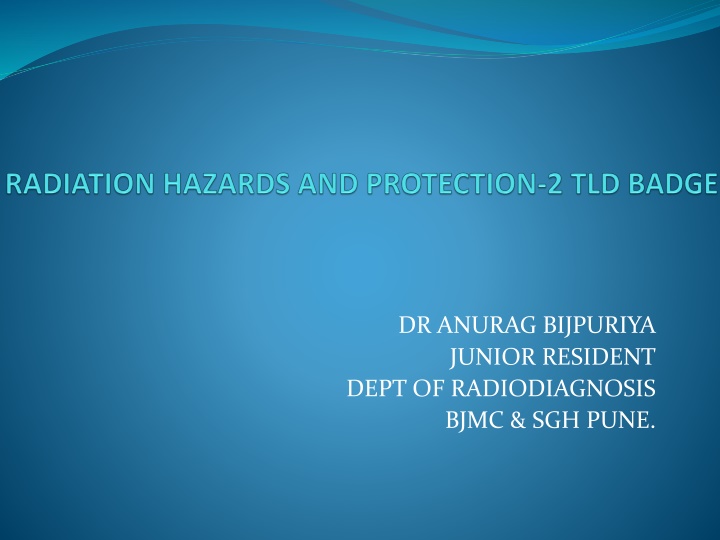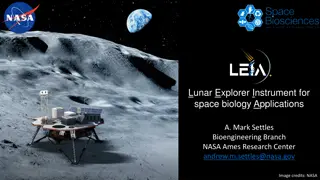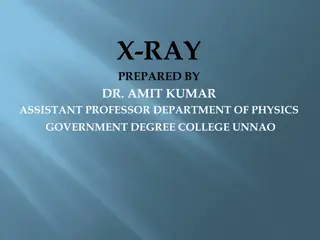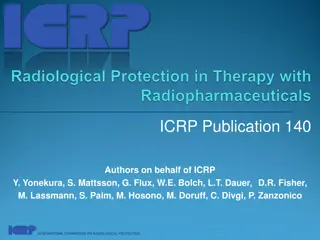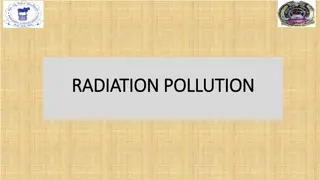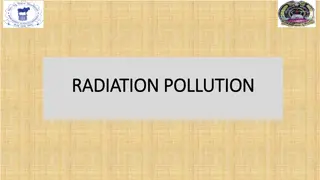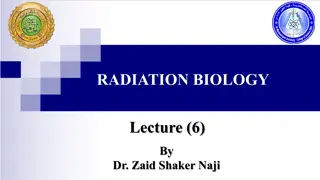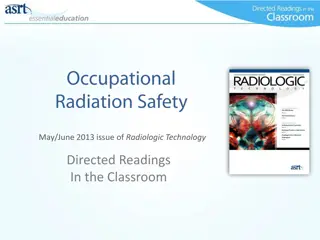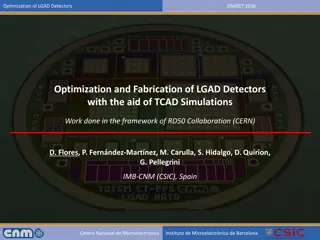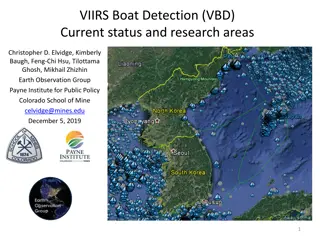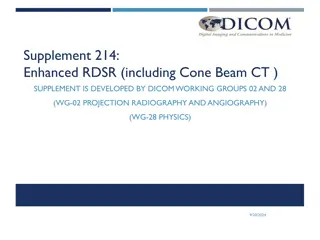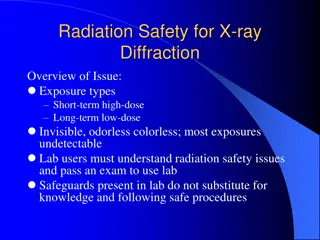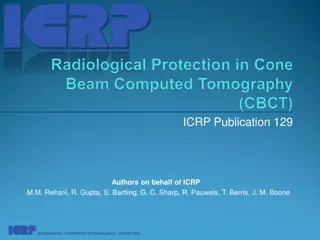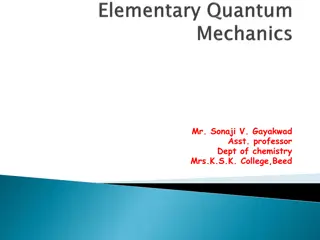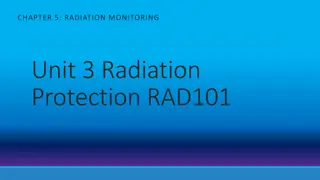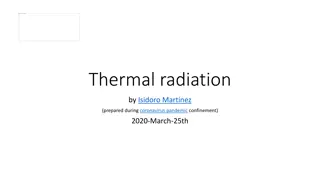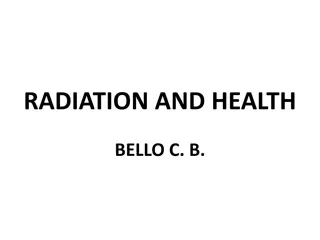Radiation Detection and Dosimetry in Medical Imaging
Radiation detection and measurement are essential in radiology. Various instruments like ionization chambers, film badges, thermoluminescent dosimeters, and pocket dosimeters are used to monitor radiation exposure. Personnel dosimetry is crucial for tracking radiation doses over time to ensure safety. Understanding ionization, photographic effects, luminescence, and scintillation is key in effective radiation detection.
Uploaded on Sep 11, 2024 | 2 Views
Download Presentation

Please find below an Image/Link to download the presentation.
The content on the website is provided AS IS for your information and personal use only. It may not be sold, licensed, or shared on other websites without obtaining consent from the author.If you encounter any issues during the download, it is possible that the publisher has removed the file from their server.
You are allowed to download the files provided on this website for personal or commercial use, subject to the condition that they are used lawfully. All files are the property of their respective owners.
The content on the website is provided AS IS for your information and personal use only. It may not be sold, licensed, or shared on other websites without obtaining consent from the author.
E N D
Presentation Transcript
DR ANURAG BIJPURIYA JUNIOR RESIDENT DEPT OF RADIODIAGNOSIS BJMC & SGH PUNE.
Radiation detection and measurement The instrument used to detect radiation are referred to as radiation detection devices. The instrument used to measure radiation are called radiation dosimeters. Methods of radiation detection 1] Ionization 2] Photographic effect. 3]Luminescence 4] Scintillation.
1) Ionisation- The ability of radiation to produce ionization in air is the basis for radiation detection by ionization chamber. 2) Photographic effect- The ability of radiation to blacken photographic films is the basis of detectors that use film. 3)Luminescence- Luminescence is the property of certain material to emit light when they are stimulated by a physiological process, a chemical, or a electrical action or by a heat. 4) Scintillation- Scintillation refers to flash of light. It is a property of certain crystals such as sodium iodide and cesium to absorb radiation and convert it to light.
Personnel dosimetry Personnel dosimetry refers to monitoring of individuals who are exposed to radiation during the course of the work. The radiation measurement is a time-integrated dose, ie the dose summed over a period of time, usually about 3 months. The dose is subsequently stated as an estimate of the effective dose equivalent to the whole body in mSv for the reporting period. Various personnel dosimeters are Pocket dosimeter Film badge monitoring Thermoluminescent dosimetry (TLD) monitoring
Pocket dosimeter The pocket dosimeter monitors dose to personnel. It consists of an ionization chamber with an eyepiece and a transparent scale as well as a hollow charging rod and a fixed and a movable fiber. When x rays enters the dosimeter, ionization causes the fibers to lose their charges and as a result, the movable fiber moves closer to the fixed fiber. The movable fiber provides an estimate of gamma or x ray dose rate.
Film badge monitoring These badges use small x rays films sandwiched between several filters to detect radiation. Film badges are inexpensive, easy to use and easy to process. Although they are useful for detecting radiation at or above 0.1 mSv (10 mrem), they are not sensitive enough to capture lower levels of radiation. Their susceptibility to fogging caused by high temparature and light means that they cannot and should not be worn for longer than 4 week period at a stretch. Another major drawback of film badge monitoring is that it is an enormous task to chemically process a large number of small films and subsequently compare each to some standard test film.
TLD badge Thermo luminescent is the property of certain material to emit light when they are stimulated by heat. Material such as lithium fluoride (LiF), Lithium Borate, Calcium Fluoride, and Calcium Sulfate have been used to make TLDs. When an Lithium Fluoride crystal is exposed to radiation, a few electrons become trapped in higher energy levels. For these electrons to return to their normal energy levels the LiF crystal must be heated. As the electron return to their stable state, light is emitted because of the energy difference between two orbital levels.
The amount of light emitted is measured by a photomultiplier tube and it is proportional to the radiation dose. The measurement of radiation from TLD is a two step procedure. In step 1 TLD is exposed to radiation. In step 2 The LiF crystal is placed in a TLD analyzer, where it is exposed to heat, as the crystal is exposed to increasing temperature , light is emitted, when the intensity of light is plotted as a function of the temperature, a glow curve results, glow curve can be used to find out how much radiation is received by the crystal.
Types of TLD Badges 1) Chest badge- Used for estimation of the whole body dose, worn at the chest level. 2) Wrist badge- Has a strap to be worn around wrist. It is used to estimate the dose to hands and to the forearms when they are likely to be selectively exposed. Units of equivalent dose Sievert is the unit of radiation equivalent dose 1 Sievert(Sv) =1 joule/kg= 100 Rem 1 millisievert(mSv)= 1/1000Sv= 1000 mRem
Equivalent Dose/ Effective Dose The cumulative effective dose (whole body dose) constraint for five years block shall be 100 mSv ieaverage 20 mSv per year in this 5 years block. In one year the individual effective dose shall not exceed 30 mSv. Annual equivalent dose limit for the skin, the hand and feet is 500 mSv and for the lens of the eye is 150 mSv. Women radiation workers of reproductive age should normally be employed in areas where radiation shall be uniform not more than 20 mSv per year When pregnancy has been diagnosed arrangement should be made to ensure that she will work only in the areas where exposures are most unlikely to exceed 2 mSv (200 mrem) during the remaining period of pregnancy.
General features of TLD Badges It consists of a TLD card loaded in a cassette having suitable metallic filters. TLD Card- A TLD card essentially consists of three CaSo4Dy-Teflon TLD discs (13.3 mm diameterX 0.8 mm thick) mechanically clipped over three symmetrical circular holes each of diameter 12 mm on a nickel plated aluminum (55.5 X 29.9 X 1mm). An asymmetric v cut provided at one end of the card ensures a fixed orientation of card in TLD cassette . A thin paper wrapper (12mg/cm2) provides personal data and the period of use.
To protect the TLD discs from dust and mishandling the card along with its wrapper is sealed in a thin plastic (polythene) pouch. Pouch also protects the card from radioactive contamination while working with open sourrces. TLD cassette- TLD cassette (card holder) is made up of high impact plastic. TLD card when inserted in the proper position in the cassette will have the first disc (D1) sandwiched between a pair of filter combination of 1 mm A1 and 0.9 mm cu (1000 mg/cm2, total thickness).Copper filter is nearer to the TLD disc. The second disc (D2) is sandwiched between a pair of 1.5 mm thick plastic filters(180 mg/cm2). The third disc (D3) is positioned under a circular open window. A clip or strap attachment affixes the badge to the user s clothing or to the wrist.
Wearing the TLD badge One TLD badge should be worn compulsorily at the chest level. If a lead rubber apron is used (eg in diagnostic X ray departments) TLD badge should be worn under the lead apron at the chest level. The dose recorded by the TLD badge worn at the chest level represents the whole body dose equivalent. In special cases depending upon the nature of radiation work, if the doses to the hands and forearms are expected to be significantly higher than at the chest level, additional wrist badges should be used.
How to use The TLD cards shall not be used without being loaded in the cassette. Once the card is loaded in the cassette, it should not be removed till the end of the service period. Whenever working in the radiation field, it should be worn. A TLD badge allotted to one user should not be shared by any other person. Each institution should keep apart one TLD card loaded in chest TLD holder as control which is required for correct dose evaluation. The control badge should be stored in a radiation free area.
While working in the premises of the institution workers should submit their badge in the place where control badge is kept. A TLD cassette holder showing any of its filters (metallic pieces) loose or otherwise damaged should not be used. It should be ensured that the TLD badge is not left in the radiation field or near hot plates , ovens, furnaces and burners etc. Institution using open/unsealed radioactive sources should periodically check the TLD cassette for radioactive contamination. The contaminated cassette should be disposed of as radioactive waste. It should not be sent dose measurement.
TLD personal monitoring service It is done by Avanttec laboratories private limited in India. On receipt of a request form an institution desirous of availing of the TLD personal monitoring services Avanttec laboratories pvt limited will sen copies of the application form for personal monitoring (PMS form), the personal data form (PDF form) and user s manual. The application form and personal data forms should be duly filled and returned to senior scientific officer , Avanttec laboratories pvt ltd, chennai. Service period depending upon the type of installation the TLD service to an institution may be monthly or quarterly basis. After one service period the used cards have to be replaced by the fresh cards sent by Avanttec for the next service period.
Dose reports The dose reports are sent after processing the respective personal TL cards and contain current period doses and up to date cumulative doses of the year. Annual dose reports are sent after the end of the year and contain annual doses and cumulative life time doses of all radiation workers by personal monitoring service or Avanttec.
Over exposures Dose equivalent recorded by chest badge exceeding 10 mSv (1000 mRem) is treated as overexposure and same is reported promptly to the institution and the individual concerned by TLD personal monitoring service. The institution should arrange to investigate the cases of overexposures and report the findings to Avanttec and it is communicated to appropriate authorities of BARC. The person receiving more than 100 mSv will be subjected to hematological examinations including differential blood counts and chromosome aberration test at BARC, Mumbai and advised for follow up.
DO NOTS Don t share your TLD badge with someone. Once loaded don t open the badge with till the end of the service period. Don t pierce or open the sealed polythene polythene pouch of TLD card. Don t use a damage or broken cassette / of which filters have come out. Don t leave the badge in radiation area, in washing area, in the vicinity of hot plates, ovens or furnaces. Don t wait till the end of the service period if you suspect a high radiation exposure , report it immediately to your supervisor who will arrange to send the TLD card for processing.
DOs Load the card properly in the cassette Use TLD card of the valid service period. Handle the TLD badge with care Store the badge in radiation free area when the badge is not in use. Report any unusual radiation incident to your supervisor/ RSO/ head of the institution. In case of any doubt kindly contact personal monitoring service.
Charge of personal monitoring services are as follows- Processing charge per TLD card Rs 125/- Lost/ Tampered/ Overexposed / Contaminated card which needs to be replaced Rs 143/- Chest TLD Cassette Rs 86/- Registration charges for new radiation workers Rs 150/-
Summary As a result of increased radiation exposure, it is necessary to monitor human exposure to radiation. Personal radiation dosimetry is the science used to monitor radiation exposure. A TLD dosimeter is a device used to monitor personal radiation dose. A TLD measures ionizing radiation exposure by measuring the amount of visible light emitted from a crystal in the detector when the crystal is heated. The amount of light emitted is dependent upon the exposure. After exposure the TLD stores the measured dose for a long period of time. There are many different types of dosimeter that are used include pocket dosimeter, film badge monitoring and TLD badges, they all perform the same basic function ie radiation monitoring.
